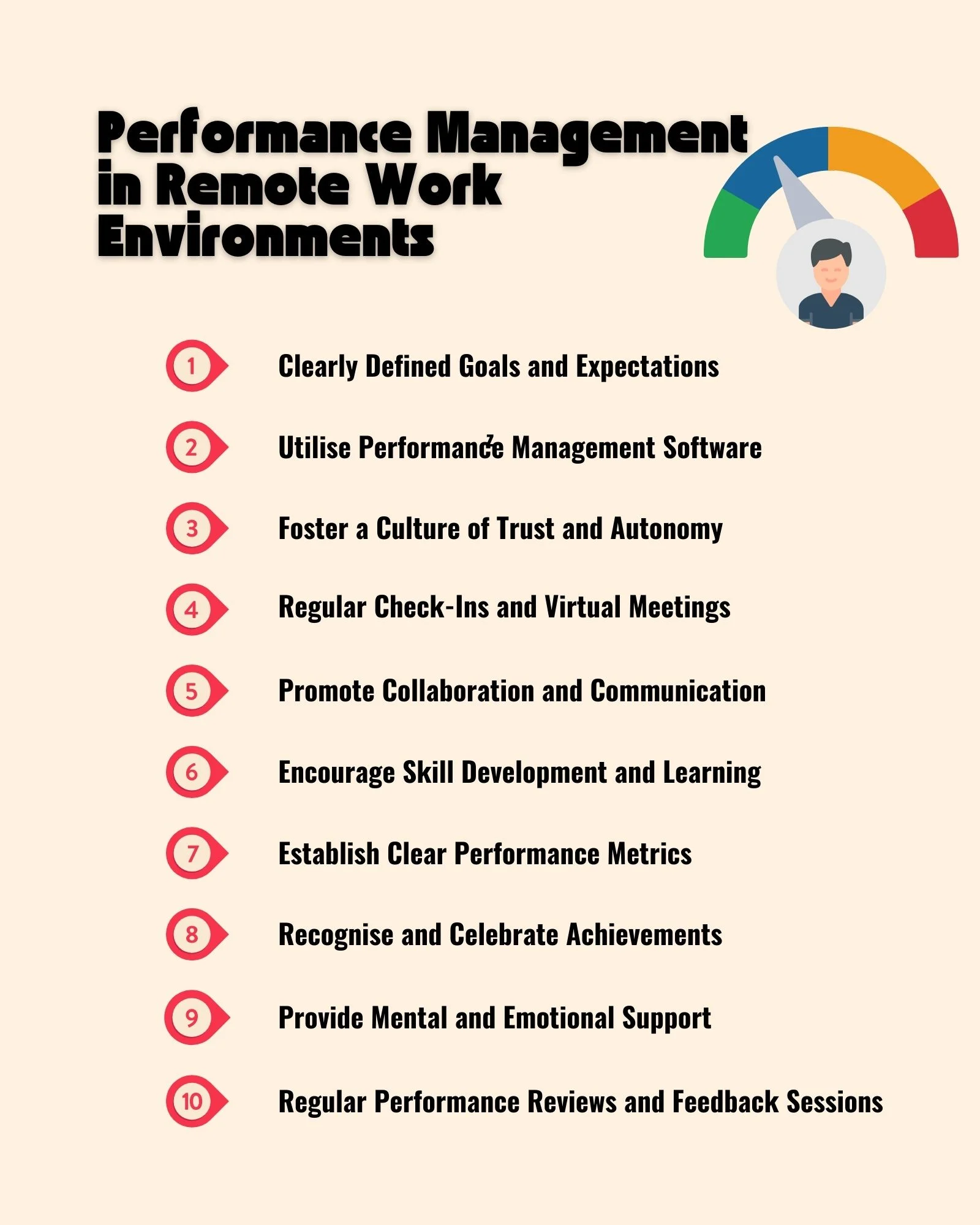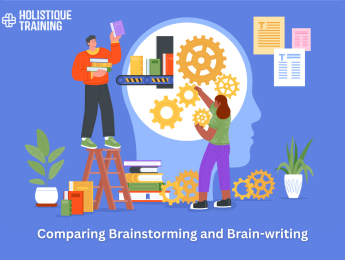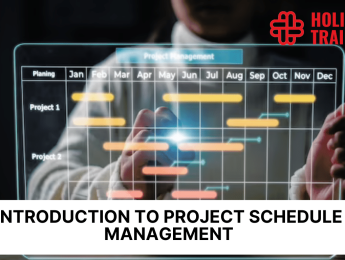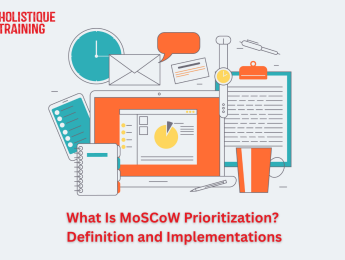Introduction
Effective performance management is a crucial aspect of any successful organisation. It involves setting clear expectations, providing feedback, and aligning individual goals with the company's overall objectives. In this blog post, we will explore the concept of performance management, its significance, and the pitfalls to avoid. Additionally, we will provide seven practical tips to help you manage employee performance effectively, fostering a productive and motivated workforce.
What Is Performance Management?
Performance management can be defined as an ongoing process that involves establishing goals, assessing progress, providing feedback, and rewarding achievements to enhance individual and organisational performance. It aligns employees' efforts with the company's strategic objectives, ultimately contributing to improved productivity and employee engagement.
Why Is Performance Management Important?
A robust performance management system offers a myriad of advantages to both employees and organisations:
Clarity and Purpose
Effective performance management provides a clear roadmap for employees. When goals and expectations are well-defined, individuals understand what is expected of them. This clarity instils a sense of purpose, allowing employees to align their daily tasks with broader organisational objectives. When everyone knows their role and understands how their work contributes to the company’s mission, motivation and job satisfaction soar. It's akin to giving each employee a piece of a puzzle; they see the bigger picture and understand how their efforts fit into it.
Communication and Feedback
One of the core tenets of performance management is regular feedback. Constructive feedback, provided in a timely manner, serves as a guide for employees to improve. It acknowledges their strengths and highlights areas for growth. When employees receive consistent feedback, they feel valued and supported. Moreover, this open communication channel allows managers to recognise potential issues early on, addressing them before they escalate. Timely interventions and support foster a culture of continuous improvement, nurturing both personal and professional growth.
Fairness and Transparency
An effective performance management system ensures fairness. When employees understand that their performance evaluations are based on standardised criteria, it reduces the perception of bias. Fair evaluations build trust within the organisation. Employees are more likely to invest themselves fully when they believe they will be recognised and rewarded justly for their efforts. Transparency in performance assessments also enhances the organisation’s credibility. It shows that promotions, bonuses, and other rewards are distributed based on merit, fostering a sense of equity among the workforce.
Employee Development
Performance management is not just about evaluating past performance; it's about planning for the future. Through regular performance reviews and discussions, employees can identify their strengths and areas needing improvement. With this knowledge, tailored development plans can be created. These plans might include training programmes, mentoring opportunities, or special projects. Investing in employee development enhances their skills and prepares them for future organisational roles. This focus on long-term growth is a powerful motivator, encouraging employees to stay committed to their jobs and the organisation.
Organisational Alignment
An organisation functions optimally when every employee is aligned with its strategic goals. Effective performance management ensures that individual efforts are directed towards overarching organisational objectives. Employees who understand how their work contributes to the company's mission are more engaged and motivated. This alignment is crucial, especially in large organisations where various departments and teams must work cohesively. Performance management acts as the glue that binds individual goals with broader strategic initiatives, creating a harmonious and goal-oriented workplace culture.
In summary, the significance of effective performance management cannot be overstated. It goes beyond the traditional employee evaluation process; it is the lifeblood that courses through the veins of a thriving organisation. It provides clarity, encourages communication, ensures fairness, fosters development, and aligns individual aspirations with collective organisational goals. By recognising the profound impact of performance management, organisations can create an environment where employees thrive, innovation flourishes, and the company propels toward unparalleled success. Remember, a well-managed workforce is not just an asset; it's the heart and soul of a prosperous organisation.
Common Pitfalls in Performance Management
While performance management is crucial, a poorly executed process can lead to various challenges and negative outcomes. Some common pitfalls to avoid include:
Lack of Clarity
When goals and expectations are ambiguous, employees are left adrift and unsure of their expectations. This lack of clarity creates confusion, leading to underperformance. Organisations must set clear, specific, measurable, achievable, relevant, and time-bound (SMART) goals. Clear objectives give employees a sense of direction, allowing them to channel their efforts effectively.
Inadequate Feedback
Feedback is the cornerstone of improvement. However, vague or infrequent feedback hampers an employee’s ability to grow. Constructive feedback should be specific, actionable, and timely. Managers should not shy away from discussing both strengths and areas needing improvement. A lack of feedback deprives employees of the opportunity to enhance their skills, hindering their professional development.
Inconsistent Measurement
Inconsistency in evaluating employee performance across the organisation breeds resentment and disengagement. Employees talk, and trust in the system is eroded when they perceive that different standards are applied to different individuals. Objective criteria, uniformly applied, ensure fairness. Performance evaluations should be standardised, ensuring everyone is assessed using the same metrics, thereby eliminating any hint of favouritism.
Neglecting Development
A myopic focus solely on an employee's current performance, without consideration for their long-term growth, is a recipe for stagnation. Performance management should identify current strengths and weaknesses and develop a roadmap. This may include additional training, mentoring, or exposure to diverse projects. Neglecting employees' future potential not only demotivates them but also deprives the organisation of valuable future leaders.
Lack of Recognition
Failure to acknowledge and celebrate exceptional performance is a missed opportunity. Recognition is a powerful motivator, reinforcing positive behaviour and encouraging employees to excel. Whether it's a simple acknowledgement during a team meeting, a personalised email from a manager, or a formal recognition programme, acknowledging achievements boosts morale and encourages consistent high performance.
Recognition Type | Impact on Employee Engagement | Impact on Productivity |
Verbal Appreciation | Boosts morale and creates a positive work culture. | Increases motivation and enthusiasm. |
Awards and Trophies | Enhances sense of accomplishment and pride. | Encourages continuous high performance. |
Public Acknowledgment | Fosters a sense of belonging and teamwork. | Drives healthy competition and innovation. |
Performance Bonuses | Provides tangible rewards for exceptional work. | Boosts financial motivation and loyalty. |
Career Advancement | Inspires long-term commitment and dedication. | Encourages skill development and expertise. |
Table 1: Types of recognition and their impact
Insufficient Communication
Open communication between managers and employees is vital for a healthy work environment. Regular discussions about goals, progress, and expectations give employees a sense of involvement and belonging. Lack of communication leads to misunderstandings, creates a void, and can even cause talented employees to feel undervalued and unappreciated.
Neglecting Employee Input
Employees are not passive entities; they are valuable contributors with unique insights. Involving them in the goal-setting process gives them a sense of ownership and ensures that their goals align with the organisation's objectives. Ignoring their input can lead to disengagement and a lack of commitment.
Each of these pitfalls, if unaddressed, can result in a toxic work environment where employees are demotivated, disillusioned, and disengaged. It can lead to high turnover rates, decreased productivity, and a negative organisational culture. Recognising these pitfalls is the first step toward avoiding them, ensuring that the performance management process becomes a source of inspiration, growth, and organisational success. By sidestepping these common traps, organisations can create a positive, motivating, and empowering performance management environment where employees thrive, and the organisation prospers.
Consequences of Poor Performance Management
A poor performance management process can have detrimental effects on both employees and the overall organisation. Let's explore some of the consequences that can arise from an ineffective performance management approach:
Low Morale and Motivation
When employees' efforts go unnoticed and unrewarded, their morale becomes nosedive. A lack of recognition and constructive feedback leads to demotivation. Employees who feel undervalued become disengaged, leading to a pervasive sense of disillusionment within the workforce. Low morale saps energy and enthusiasm, stifling creativity and innovation.
Decreased Productivity
Clarity in goals and expectations is essential for productivity. Poorly managed employees lack direction and struggle to prioritise tasks effectively. When they don’t understand how their work contributes to the larger organisational objectives, they might focus on the wrong tasks or work without enthusiasm, decreasing efficiency and productivity.
High Turnover Rates
Employees who feel undervalued or unsupported may seek opportunities elsewhere. A poor management process that neglects development, recognition, and growth can lead to increased turnover rates, resulting in talent loss and higher recruitment costs. In fact, according to Plecto, an astonishing 70% of an employee's motivation is impacted by their manager. Consequently, this lack of motivation directly correlates with an increased employee turnover rate.
Conflict and Poor Relationships
A lack of clear communication and feedback creates misunderstandings. Employees may feel unfairly treated, leading to tensions within teams. Poorly managed performance evaluations can create animosity between managers and employees, hindering collaboration and teamwork. Conflict-ridden environments are not conducive to creativity or efficient work processes.
Missed Opportunities for Improvement
Without proper guidance and support, employees cannot effectively address their weaknesses. They miss opportunities to learn and grow, limiting their potential. In the absence of corrective feedback and developmental initiatives, skills stagnate, hindering employees' personal and professional growth.
Inequality and Unfairness
Inconsistencies in performance evaluations breed perceptions of favouritism. When some employees receive preferential treatment, trust in the organisation is eroded. This sense of unfairness results in dissatisfaction and a lack of commitment. Employees may start to question the integrity of the management, creating a toxic work environment.
Impact on Organisational Success
Ultimately, the consequences of poor performance management affect the organisation's success. Unaddressed performance issues, lack of employee development, and disengagement can hinder progress toward strategic goals. This impact is not limited to individual teams; it permeates the entire organisation. Failed projects, missed opportunities, and dissatisfied customers can all be traced back to the lack of an effective performance management system.
In short, the consequences of poor performance management are far-reaching and detrimental. They affect individual employees, the overall organisational culture, and success. Recognising and rectifying these issues is imperative for creating a positive work environment where employees feel valued, motivated, and engaged. Investing in effective performance management practices boosts individual morale and productivity and contributes significantly to the organisation's bottom line. It fosters a culture of continuous improvement, encouraging employees to strive for excellence and actively participate in the organisation’s journey toward success.
7 Tips to Managing Employee Performance Effectively
Now that we understand the importance of performance management and the pitfalls to avoid, let's explore seven practical tips to help you manage employee performance effectively:
1. Set Clear Expectations
Transparent communication is the bedrock of effective performance management. Clearly define individual and team goals, ensuring they align with the organisation's strategic objectives. These goals should be SMART (Specific, Measurable, Achievable, Relevant, and Time-bound). When employees understand what is expected of them, they are better equipped to channel their efforts in the right direction.
2. Provide Ongoing Feedback
Feedback should be a continuous dialogue rather than an annual event. Regular, timely feedback, both positive and constructive, is essential. Positive reinforcement boosts morale, while constructive feedback, when given respectfully, provides employees with actionable insights for improvement. Managers should encourage an open-door policy, making employees feel comfortable discussing their concerns and challenges.
3. Conduct Regular Check-Ins
Scheduled one-on-one meetings between managers and employees are invaluable. These meetings provide a dedicated space for discussing progress, challenges, and goals. They should be open, honest, and respectful conversations where employees can express their opinions and managers can provide guidance. These check-ins build trust and foster a sense of mutual understanding.
4. Collaborate on Goal-Setting
Involving employees in the goal-setting process fosters a sense of ownership and commitment. Encourage employees to set their own goals within the framework of organisational objectives. When employees actively participate in defining their goals, they are more motivated to achieve them. This collaborative approach also ensures that goals are realistic and achievable.
Benefits | Description |
Enhanced Commitment | Employees feel ownership and responsibility for goals |
Improved Alignment | Individual objectives align with organised goals |
Increased Motivation | Involvement fosters a sense of purpose and motivation |
Enhance Creativity and Innovation | Employees offer diverse ideas for goals achievement |
Higher Accountability | Personal investment leads to increased accountability |
Table 2: Benefits of employee involvement in goal-setting
5. Offer Training and Development Opportunities
Investing in employee development is an investment in the organisation's future. Provide relevant training programmes, workshops, and mentoring opportunities. Continuous learning enhances employees' skills and knowledge and boosts their confidence and job satisfaction. Development opportunities signal to employees that the organisation values their growth and is willing to invest in their potential.
6. Recognise and Reward Achievement
Acknowledging exceptional performance is a powerful motivator. In fact, according to a recent survey, 37% of employees highlighted how important employee recognition is to them. To ensure your employees are recognised, implement a structured recognition programme that rewards employees for their hard work and achievements. Recognition can take various forms, such as verbal praise, certificates, awards, or financial incentives. Celebrating accomplishments publicly not only boosts the morale of the recognised employee but also sets a positive example for the entire workforce.
7. Document and Evaluate Performance
Maintain a comprehensive record of employee performance, accomplishments, and areas for improvement. Regularly evaluate progress against set goals and provide constructive feedback based on objective and consistent criteria. Documenting performance data aids in identifying patterns, trends, and areas needing improvement. It also serves as a valuable resource during performance appraisals and facilitates fair and transparent evaluations.
Incorporating these practical tips into the performance management process creates a culture of accountability, collaboration, and continuous improvement. It fosters a positive work environment where employees are motivated, engaged, and committed to achieving their best. Effective performance management is not a one-size-fits-all solution; it requires adaptability, empathy, and a genuine interest in employees' well-being and professional growth. Organisations implementing these strategies enhance their productivity and innovation and create a workplace where employees feel valued and inspired to excel. Remember, successful performance management is not just a process; it's a commitment to nurturing talent, fostering growth, and building a resilient and high-performing workforce.
Performance Management in Remote Work Environments
The advent of remote work has transformed the traditional landscape of performance management. Managing a dispersed workforce requires different strategies and tools to ensure that employees remain motivated, engaged, and productive. Here are essential considerations and strategies for effective performance management in remote work environments:

1. Clearly Defined Goals and Expectations
Clear communication becomes even more critical in remote work settings. Managers must establish well-defined goals and expectations for each employee. Objectives should be specific, measurable, and time-bound. Clear guidelines on performance metrics help remote workers understand what is expected of them, ensuring alignment with organisational goals.
2. Utilise Performance Management Software
Implementing performance management software is pivotal in remote work scenarios. These tools enable real-time tracking of tasks, goals, and achievements. They also facilitate continuous feedback loops, ensuring that employees receive timely guidance and recognition. Performance management software enhances transparency and allows both managers and employees to monitor progress effortlessly.
3. Foster a Culture of Trust and Autonomy
Trust is the cornerstone of successful remote performance management. Managers should focus on outcomes rather than micromanaging processes. Encouraging autonomy empowers employees to manage their work schedules effectively. Trusting employees to deliver results fosters a sense of responsibility, increasing self-motivation and productivity.
4. Regular Check-Ins and Virtual Meetings
Scheduled virtual check-ins and meetings are vital for maintaining a sense of connection. Regular one-on-one meetings allow employees to discuss challenges, seek guidance, and share progress. These interactions, whether daily stand-ups or weekly team meetings, enhance communication and combat feelings of isolation among remote workers.
5. Promote Collaboration and Communication
Effective collaboration is essential, even in remote environments. Encourage the use of collaboration tools, project management software, and instant messaging platforms. Facilitate team discussions and brainstorming sessions through virtual meetings. A strong emphasis on communication channels helps remote teams stay connected and fosters a collaborative spirit.
6. Encourage Skill Development and Learning
Remote work provides an excellent opportunity for employees to invest in skill development. Encourage participation in online courses, webinars, and workshops. Consider offering learning stipends to support continuous education. Investing in skill development enhances employee capabilities and aligns their expertise with organisational needs.
7. Establish Clear Performance Metrics
Define clear and measurable performance metrics tailored to remote work scenarios. These metrics can include project completion timelines, client satisfaction ratings, or other key performance indicators (KPIs) specific to the role. Transparent metrics give remote employees a tangible sense of their contributions and impact on the organisation.
8. Recognise and Celebrate Achievements
Recognition is equally important in remote work environments. Celebrate achievements publicly, acknowledging the efforts of remote employees. Virtual award ceremonies, shout-outs during team meetings, or personalised thank-you notes greatly make remote employees feel valued. Recognition fosters a positive work culture and boosts morale.
9. Provide Mental and Emotional Support
Remote work can sometimes lead to feelings of isolation and stress. Managers should be empathetic and provide emotional support to remote employees. Encourage open conversations about mental health and well-being. Offer resources such as counselling services or mental health webinars to support employees' emotional needs.
10. Regular Performance Reviews and Feedback Sessions
Remote employees deserve structured performance evaluations, just like their in-office counterparts. Conduct regular performance reviews, highlighting achievements, areas for improvement, and future goals. These reviews should be supplemented with constructive feedback and actionable suggestions for growth. Feedback sessions provide remote employees with a clear roadmap for their professional development.
Navigating the nuances of remote performance management demands proactive communication, trust-building, and the strategic use of technology. By embracing these strategies, organisations can manage remote teams effectively and create a collaborative and supportive work culture that transcends physical boundaries. Effective performance management in remote work environments is not just a challenge to overcome; it's an opportunity to redefine the future of work, fostering innovation, flexibility, and employee satisfaction.
Conclusion
Effectively managing employee performance is a critical aspect of organisational success. By implementing a robust performance management process, organisations can align individual efforts with strategic objectives, foster employee growth, and enhance overall productivity. Remember to set clear expectations, provide ongoing feedback, involve employees in goal-setting, offer development opportunities, and recognise achievements. By following these tips, you can create a positive and engaging work environment that promotes high performance and motivates your employees to reach their full potential. If you think you need more help when it comes to managing employee performance, make sure to check out our course, ‘Perfecting Your Management and Leadership Skills’. Your team will thank you later!























